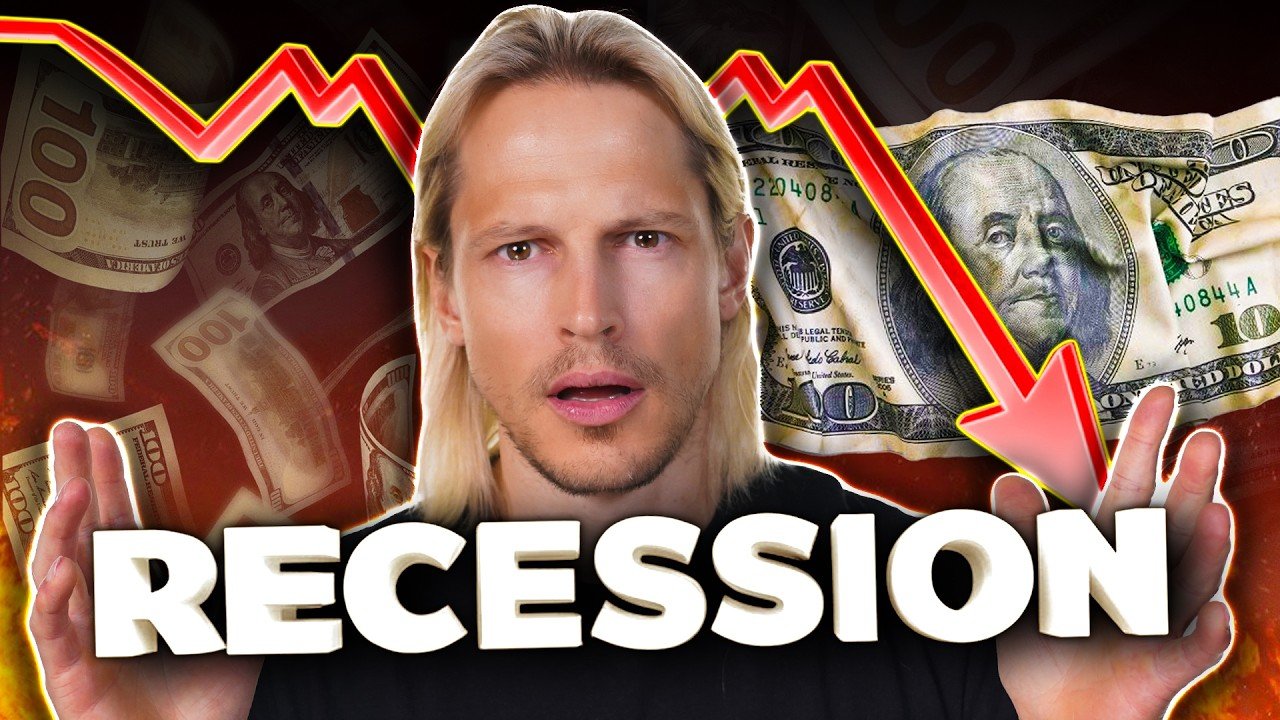In the financial landscape, interpreting early indicators of an impending recession is paramount. In this article titled “Recession Indicators: Watch Now Before It’s Too Late!”, the focus will be on dissecting July’s U.S. unemployment data, analyzing the implications of the Sahm Rule, and evaluating the historical and current economic contexts that set the stage for potential market shifts. Understanding these markers not only equips you with foresight but also enhances your strategic decisions in an uncertain economic environment.
The content is structured to offer a comprehensive overview, beginning with the initial triggers leading to recession concerns, such as heightened unemployment rates and central banks’ monetary policies. You’ll explore the deeper significance found within unemployment data anomalies, the rise of “bullshit jobs,” and the nuanced responses from both markets and policy-makers. By the conclusion, you will have a clearer grasp of the economic landscape and the critical indicators to monitor, ensuring that you are well-prepared to navigate the fiscal challenges ahead.

This image is property of i.ytimg.com.
How We Got Here
Pandemic Lockdowns and Stimulus Measures
The onset of the COVID-19 pandemic in early 2020 saw governments around the world implement strict lockdown measures to curb the spread of the virus. These unprecedented actions led to a sudden and sharp economic collapse. Businesses closed, supply chains were disrupted, and millions lost their jobs. In response, central banks slashed interest rates to historic lows and governments introduced massive fiscal stimulus packages, often referred to as “stimulus checks,” to support individuals and businesses. These measures, while providing short-term relief, laid the groundwork for long-term economic challenges.
Inflation and Central Bank Responses
By 2021, the effects of these stimulus measures began to manifest in the form of rising inflation. The influx of liquidity, coupled with supply chain disruptions and pent-up consumer demand, led to a rapid increase in prices. Central banks, particularly in the United States, were initially hesitant to act, deeming inflation “transitory.” However, as inflation persisted, they were compelled to raise interest rates aggressively throughout 2022. This was intended to curb the inflationary pressures but also carried the risk of slowing down economic growth.
Economic Indicators and Their Impact
Economic indicators such as GDP, inflation rates, and unemployment figures play critical roles in shaping monetary and fiscal policies. GDP, or Gross Domestic Product, measures a country’s economic output and overall health. Inflation rates indicate the rising cost of goods and services, while unemployment figures reveal the percentage of the workforce that is jobless but actively seeking employment. A combination of high inflation and stagnating GDP can lead to a scenario known as stagflation, which poses complex challenges for policymakers.
The Sahm Rule
Definition and Historical Accuracy
The Sahm Rule, developed by economist Claudia Sahm, is a real-time recession indicator that predicts recessions based on the rate of change in the unemployment rate over a three-month average compared to its low during the previous 12 months. Specifically, a rise of 0.5 percentage points or more in the three-month average unemployment rate above its low signals a recession. Historically, this rule has been highly accurate in identifying recessions, making it a valuable tool for economists and policymakers.
Application to Current Economic Climate
In the current climate, the Sahm Rule has garnered significant attention. Following the release of July’s unemployment figures, which showed a notable increase, the Sahm Rule was triggered, leading to heightened recessionary fears. While some argue that this is an anomaly caused by temporary factors like natural disasters and labor force fluctuations, others believe it signifies the onset of an economic downturn.
Limitations and Considerations
While the Sahm Rule is a reliable indicator, it is not without its limitations. It primarily focuses on unemployment data and may not fully capture the complexities of modern economies, which can be influenced by a myriad of factors including global trade, technological advancements, and policy changes. Additionally, the rule does not account for underemployment or discouraged workers not actively seeking jobs. Policymakers must consider these limitations when using the Sahm Rule to guide economic decisions.
Unemployment Data
July’s Unemployment Report
The July unemployment report revealed a higher-than-expected increase in the unemployment rate, causing significant concern in the markets. This rise was seen as a potential early warning sign of an economic slowdown. However, it is essential to analyze the broader context and underlying factors contributing to this data to avoid overreaction based solely on a single data point.
Factors Affecting Unemployment Statistics
Various factors can influence unemployment statistics. Seasonal variations, such as increased hiring during the holiday season, can affect short-term unemployment rates. Economic policies, immigration rates, and changes in labor force participation also play significant roles. Natural disasters or pandemics can cause temporary spikes in unemployment, which may not accurately reflect long-term trends.
Long-term Implications of Unemployment
Sustained high unemployment can have severe long-term implications. It can reduce consumer spending, affect mental health, and lead to a loss of skills and workforce productivity. Additionally, high unemployment can strain government resources through increased demand for unemployment benefits and social services. Addressing unemployment proactively is crucial for ensuring long-term economic stability and growth.
The Concept of Bullshit Jobs
Definition and Examples
The term “bullshit jobs,” popularized by anthropologist David Graeber, refers to positions that employees perceive as pointless or lacking a meaningful contribution to society. These jobs often exist due to corporate bureaucracy, inefficiencies, or simply as a way to fill employment quotas. Examples include certain administrative roles, middle-management positions, and roles created purely to maintain organizational hierarchy.
Impact on the Economy
Bullshit jobs can lead to economic inefficiencies, as resources are allocated to non-productive activities. They contribute to worker dissatisfaction, reducing overall productivity and innovation. In the long run, they can distort labor market statistics, presenting a rosier picture of employment than the reality, where meaningful and fulfilling job opportunities may be lacking.
Long-term Sustainability
The sustainability of an economy heavily reliant on bullshit jobs is questionable. As automation and artificial intelligence continue to advance, many of these roles may become obsolete. The challenge lies in transitioning the workforce from these positions to more productive and meaningful employment opportunities, ensuring that the economy remains dynamic and resilient.

This image is property of images.pexels.com.
What Comes Next?
Potential Central Bank Policies
Central banks, including the Federal Reserve, are closely monitoring the economic indicators to determine their next steps. Potential policies may include further interest rate adjustments to balance the dual mandate of controlling inflation and supporting employment. They may also consider unconventional measures such as quantitative easing or altering reserve requirements for banks.
Market Reaction and Predictions
The market’s reaction to central bank policies can be unpredictable. While rising interest rates typically signal tightening financial conditions and can lead to market downturns, clear and transparent communication from central banks can help mitigate panic. Analysts and investors will be closely watching for signals from central banks about their future policy directions to make informed decisions.
Economic Indicators to Watch
In addition to traditional economic indicators like GDP, inflation rates, and unemployment figures, other measures such as consumer confidence indices, business investment trends, and global economic conditions will be crucial to monitor. These indicators can provide a more comprehensive picture of the economic landscape, helping policymakers and investors navigate the complexities of the economy.
Market and Policy Responses
Interest Rates and Their Delayed Impact
Interest rate changes by central banks typically have a delayed impact on the economy. When rates are increased, borrowing costs rise, leading to reduced spending and investment over time. Conversely, rate cuts can stimulate economic activity but may also lead to higher inflation if not managed carefully. The lag in effects necessitates careful consideration and timely action by policymakers.
Fiscal Stimulus Possibilities
Fiscal stimulus, such as government spending on infrastructure projects or direct payments to citizens, can provide an immediate boost to the economy. However, it comes with the risk of increasing national debt and potentially leading to inflation if not implemented judiciously. Policymakers must balance the short-term benefits of fiscal stimulus with its long-term economic implications.
Divergence Between GDP and Unemployment
A divergence between GDP and unemployment can present a complex policy landscape. For instance, a scenario where GDP growth remains strong while unemployment rises could indicate structural issues in the labor market. Policymakers would need to address these underlying issues through targeted interventions, such as workforce retraining programs and incentives for job creation, to align economic growth with employment opportunities.

This image is property of images.pexels.com.
Implications for Economy and Markets
Short-term Market Boom Potentials
Introduction of new stimulus measures or monetary easing could potentially lead to short-term market booms. Investors often react positively to policies that inject liquidity into the economy, driving up asset prices. However, such booms may not be sustainable if they are not backed by fundamental economic improvements.
Concerns About Policy Sustainability
The sustainability of economic policies is a significant concern. Prolonged dependence on low interest rates and fiscal stimulus can lead to imbalances, such as excessive national debt and asset bubbles. Policymakers must ensure that short-term measures do not undermine long-term economic stability.
Impact on Ordinary Americans
Economic policies have direct and tangible impacts on everyday Americans. Rising interest rates can increase mortgage and loan costs, while fiscal stimulus can provide short-term financial relief. Policymakers must consider the broader implications of their actions, ensuring they support economic stability and growth while addressing the needs and concerns of ordinary citizens.
Public Perception vs. Official Statistics
Discrepancies Between Public Sentiment and Data
There can often be a significant gap between public sentiment and official economic statistics. While data may indicate economic growth or low unemployment, individuals may still feel financial strain due to factors like wage stagnation, rising living costs, or job insecurity. Understanding and addressing this discrepancy is crucial for creating policies that genuinely improve economic well-being.
Media Influence on Economic Perception
Media plays a critical role in shaping public perception of the economy. Sensational headlines and selective reporting can create a skewed view of economic conditions, leading to misplaced fears or undue optimism. It is essential for the media to provide balanced and accurate reporting, helping the public make informed decisions.
Potential Manipulation of Economic Data
There is always a risk of economic data being manipulated for political or ideological purposes. While official statistics are typically generated by impartial agencies, the interpretation and presentation of this data can be influenced by political agendas. Transparency and rigorous oversight are essential to maintain the integrity of economic data.

This image is property of images.pexels.com.
Political and Economic Maneuvers
Strategies Around Upcoming Elections
With elections on the horizon, political leaders often use economic data to bolster their positions or attack their opponents. Policies may be introduced or adjusted to appeal to voters, sometimes at the expense of long-term economic health. Understanding these political maneuvers can help voters critically assess the motivations behind economic policies.
Use of Economic Data for Political Gain
Economic data is a powerful tool for political leaders. Positive indicators can be highlighted to showcase successful governance, while negative data can be used to critique opponents. The careful use and sometimes manipulation of economic data for political gain is a common strategy in election periods, affecting how policies are shaped and promoted.
Public Reaction and Trust Levels
Public trust in economic data and policies is paramount. Erosion of trust can lead to skepticism and resistance to policy measures, undermining their effectiveness. Ensuring transparency and demonstrating the reliability of economic data are essential for maintaining public trust and support for economic policies.
Conclusion
Summarizing Key Indicators to Watch
In the current economic climate, key indicators to watch include GDP growth rates, inflation trends, and unemployment statistics. Additionally, tracking consumer confidence, business investment, and global economic developments will provide a more comprehensive understanding of economic health and potential future trends.
Encouragement to Stay Informed
Staying informed about economic conditions and policies is vital for making sound financial decisions. Engaging with reliable sources of information and critically analyzing economic data can help individuals navigate the complexities of the economy more effectively.
Final Thoughts on Economic Preparedness
Economic preparedness involves understanding the broader economic trends and their potential impacts on personal finances. By staying informed, individuals can better anticipate changes and make proactive decisions to protect and grow their financial well-being in uncertain times. As we navigate these challenging economic conditions, informed citizens are the backbone of a resilient economy.